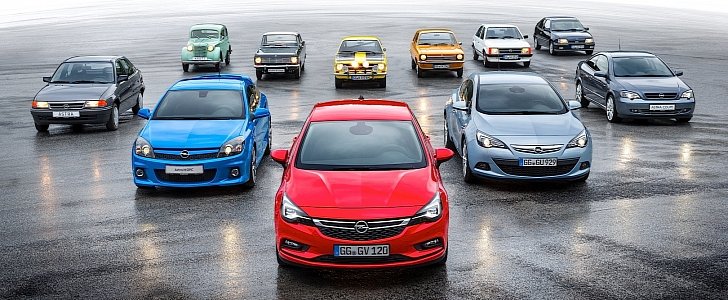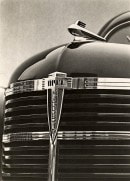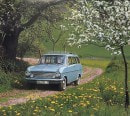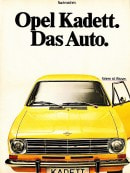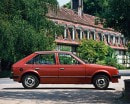We’ve heard that there’s an all-new Opel Astra slated to make its first public outing in September at the IAA in Frankfurt. Though it was constantly overshadowed by the Golf - the C-segment’s sweetheart, there’s a bit more to the Opel Astra than meets the eye. As a start to our visual guide of the Astra, did you know that the original predates the Beetle by two years?
Ferdinand Porsche produced the first Volkswagen Beetle Type 1 in 1938, two years after the Opel Astra’s predecessor went into mass production. From the Opel Kadett 1 to the Astra K there are 79 years that are full of understated automotive glory. Fun fact: the Kadett and Astra are the German brand’s bestsellers.
According to the German manufacturer, over 24 million of the things were built in that timeframe. If you line them one behind the other, Opel’s compact vehicle production would surpass 100,000 kilometers, a length that would circle the equator two and a half times. And all of these feats happened under GM’s rule, which acquired the Opel marque in 1929 because higher-ups were impressed with Opel’s modern production facilities.
Speaking of the Astra’s predecessor, it was the Kadett that made Opel come up with the “Das Auto” slogan, still used today. There are a plethora of reasons why the Kadett and Astra are the backbone of the Opel A.G. company, so let’s proceed with the original - the Opel Kadett 1 people’s car.
This technical solution is the predecessor of modular vehicle platforms, and it permitted Opel to offer the Kadett 1 in sedan or convertible forms, with the price starting at 2,100 German marks. Top speed was just under 100 km/h (62 mph). On the oily bits front, the 1936 Opel Kadett boasted Dubonnet-type independent front suspension and the leaf-spring rear axle of the Opel Olympia. An L-head 4-cylinder cast-iron engine was employed from the Opel P 4, generating 23 HP from 1,073 cc.
From ’62 to ’65, some 650,000 examples of the Kadett A were manufactured in two-door notchback guise. Want to hear what can only be described as a sacrilege for that era’s automotive dos and don’ts? It had its fuel filler cap outside the car! That’s the ‘60s for you and the solution to a boot that doesn’t smell of gasoline every time you open it. No wonder the marketing team was adamant that the Opel Kadett A is, in brief, “O.K.”
The 1.1-liter carburetted gasoline engine was good for 45 horsepower and 55 horsepower on the S model. Unlike its honorable predecessors, the Kadett B sold like hot cakes. Some 2.6 million examples were made all around the world, with the export quota reaching as high as 50 percent of the total production. The Kadett B was traded in 120 countries.
We’re much obliged to tell you that the design was something new for Opel, especially the flat radiator grille and front apron integrated with the spoiler. This generation of the Opel Kadett is worthy of being remembered for the GT/E model that debuted in ’75. Thanks to a 1.9L engine with fuel injection, it was good enough for 105 HP and a top speed of 184 km/h (114 mph).
Other than the 1,425-liter cargo capacity of the station wagon, the Kadett D was produced in fastback forms. Out of the 2.1 million cars produced from 1979 to 1984, the most interesting is the 1983 Opel Kadett GTE. Its 1.8-liter engine was good for 115 horsepower and a top speed of 187 km/h (116 mph). Oh, nearly forgot - ventilated disc brakes at the front for the win!
After lots of hours in the wind tunnel, the Opel Kadett GSi came into the world with a Cd of 0.30. At the time, it was heralded as the most aerodynamic hatchback in the world. Yielding 156 horsepower (115 kW), the Opel Kadett GSi/GTE’s 1.8-liter 16-valve twin-cam engine was a real treat.
Assuming the name of the Kadett’s British sibling made the compact car from Opel easier to sell around the world. The most important firsts introduced by the Astra F are an active safety belt system with tensioners for the front safety belts, height adjustments for the seat belts and seat ramps, as well as double steel tube reinforcements for all the doors for extra passenger protection. The Astra F was eco-conscious too, as all engines available came equipped with catalytic converters.
A fully galvanized body shell is another fact that made the second-generation Astra a revolutionary car. Thanks to a wheelbase that’s 10 centimeters longer than that of the Astra F, the Opel Astra G offered superior legroom and 370 liters (13 cuFT) of cargo capacity with the rear seats up.
For starters, the IDSPlus adaptive chassis with Continuous Damping Control was science-fiction for this segment in the early Noughties. Adaptive Forward Lighting headlamps with dynamic curve light assist is another highlight. Last but not least, Euro NCAP gave the Astra H 34 points. At that time, the agency’s score represented the highest rating in terms of adult passenger protection for a vehicle from the compact segment.
FlexRide adaptive damping, a modern rear axle design, and a Watt’s linkage-type suspension are what makes the Astra J handle fairly well. From the driver’s point of view, the safety ergonomics that went into the design of the front seats boast the stamp of approval from many medical and back experts.
The seats are certified by the medical boffins mentioned a little earlier, but that’s not all. They now get optional ventilation and massage function. On an ending note, the 1-liter turbo engine is the cleanest and most fuel efficient petrol-fed compact hatch on the European market.
Cometh September and we’ll meet the 2015 Opel Astra K in the flesh at the Frankfurt Motor Show.
According to the German manufacturer, over 24 million of the things were built in that timeframe. If you line them one behind the other, Opel’s compact vehicle production would surpass 100,000 kilometers, a length that would circle the equator two and a half times. And all of these feats happened under GM’s rule, which acquired the Opel marque in 1929 because higher-ups were impressed with Opel’s modern production facilities.
Speaking of the Astra’s predecessor, it was the Kadett that made Opel come up with the “Das Auto” slogan, still used today. There are a plethora of reasons why the Kadett and Astra are the backbone of the Opel A.G. company, so let’s proceed with the original - the Opel Kadett 1 people’s car.
Opel Kadett 1 (1936 - 1940)
When it was launched in 1936, the introductory Opel Kadett wasn’t hailed as a game changer. In terms of mechanicals, technology, and price, the Kadett was just a car. Still, in the four years it was made in Russelsheim, production surpassed the magical 100,000-unit mark. The four-seater car had an ace up its sleeve though - the Kadett 1’s unitary body construction.This technical solution is the predecessor of modular vehicle platforms, and it permitted Opel to offer the Kadett 1 in sedan or convertible forms, with the price starting at 2,100 German marks. Top speed was just under 100 km/h (62 mph). On the oily bits front, the 1936 Opel Kadett boasted Dubonnet-type independent front suspension and the leaf-spring rear axle of the Opel Olympia. An L-head 4-cylinder cast-iron engine was employed from the Opel P 4, generating 23 HP from 1,073 cc.
Opel Kadett A (1962 - 1965)
As the swinging ‘60s came on the scene, Opel launched the Kadett A. Its strong points were the generous boot capacity and sufficient roominess for four adults. Vector in elements such as low maintenance costs and the reliable 40 HP 1-liter engine, and you get the recipe for a commercial success story.From ’62 to ’65, some 650,000 examples of the Kadett A were manufactured in two-door notchback guise. Want to hear what can only be described as a sacrilege for that era’s automotive dos and don’ts? It had its fuel filler cap outside the car! That’s the ‘60s for you and the solution to a boot that doesn’t smell of gasoline every time you open it. No wonder the marketing team was adamant that the Opel Kadett A is, in brief, “O.K.”
Opel Kadett B (1965 - 1973)
This is the generation that kickstarted the “Das Auto” brand identity. At more than four meters long, it was larger sizably larger than the Kadett A. Despite the increase in size and practicality, the flat sloping rear harked back to American fastback sports cars like the first-generation Ford Mustang.The 1.1-liter carburetted gasoline engine was good for 45 horsepower and 55 horsepower on the S model. Unlike its honorable predecessors, the Kadett B sold like hot cakes. Some 2.6 million examples were made all around the world, with the export quota reaching as high as 50 percent of the total production. The Kadett B was traded in 120 countries.
Opel Kadett C (1973 - 1979)
For this generation of the Kadett, the nameplate spawned many body styles - the Kadett City three-door hatchback, Kadett Caravan, Kadett 4-door “Limousine,” and the Kadett Coupé. 1.7 million of these rear-wheel drive Kadett Cs were built up to 1979. What made the C worthy, you’re asking?We’re much obliged to tell you that the design was something new for Opel, especially the flat radiator grille and front apron integrated with the spoiler. This generation of the Opel Kadett is worthy of being remembered for the GT/E model that debuted in ’75. Thanks to a 1.9L engine with fuel injection, it was good enough for 105 HP and a top speed of 184 km/h (114 mph).
Opel Kadett D (1979 - 1984)
In 1974, the Kadett turned to front-wheel drive. The first FWD model in Opel history employed this technical solution to cut production cost and for better packaging. It may be 126 mm shorter than the rear-wheel drive Kadett C, but the Kadett D boasts a roomier interior, a torsion-beam rear axle and a 1.3-liter OHC petrol powerplant with either 60 or 75 horsepower.Other than the 1,425-liter cargo capacity of the station wagon, the Kadett D was produced in fastback forms. Out of the 2.1 million cars produced from 1979 to 1984, the most interesting is the 1983 Opel Kadett GTE. Its 1.8-liter engine was good for 115 horsepower and a top speed of 187 km/h (116 mph). Oh, nearly forgot - ventilated disc brakes at the front for the win!
Opel Kadett E (1984 - 1991)
Manufactured from ’84 to ’91 and selling a total of 3,779,289 units in its lifetime, the “Car of the Year 1984” was a game changer. The best-selling Opel model until that point in time boasted an aerodynamically-conscious hatchback design, enabling a drag coefficient of 0.32. Not bad for the 1980s.After lots of hours in the wind tunnel, the Opel Kadett GSi came into the world with a Cd of 0.30. At the time, it was heralded as the most aerodynamic hatchback in the world. Yielding 156 horsepower (115 kW), the Opel Kadett GSi/GTE’s 1.8-liter 16-valve twin-cam engine was a real treat.
Opel Astra F (1991 - 1997)
The turning point. The new chapter. The second coming of the Opel compact car. Whatever you want to call it, the first Astra put an end to the Opel Kadett lineage. It didn’t forget to pay tribute to its role model though, as it went to sell a mind-boggling 4.13 million units from 1991 to 1997. To this day, the Astra F is the best-selling Opel model in the company’s history.Assuming the name of the Kadett’s British sibling made the compact car from Opel easier to sell around the world. The most important firsts introduced by the Astra F are an active safety belt system with tensioners for the front safety belts, height adjustments for the seat belts and seat ramps, as well as double steel tube reinforcements for all the doors for extra passenger protection. The Astra F was eco-conscious too, as all engines available came equipped with catalytic converters.
Opel Astra G (1998 - 2004)
Adopting a more coupé-ish design, the Astra G started life as a three and five-door C-segment hatchback and as an estate. The notchback sedan, coupé, and convertible followed. Other than the aesthetic revolution, the Astra G was twice as rigid than the Astra F.A fully galvanized body shell is another fact that made the second-generation Astra a revolutionary car. Thanks to a wheelbase that’s 10 centimeters longer than that of the Astra F, the Opel Astra G offered superior legroom and 370 liters (13 cuFT) of cargo capacity with the rear seats up.
Opel Astra H (2004 - 2009)
With outputs ranging from 90 to 240 horsepower thanks to a selection of 12 engines, the H was offered in 7 body styles. Approximately 2.7 million were sold during its lifecycle. But what made the Opel (and Vauxhall) Astra H rememberable?For starters, the IDSPlus adaptive chassis with Continuous Damping Control was science-fiction for this segment in the early Noughties. Adaptive Forward Lighting headlamps with dynamic curve light assist is another highlight. Last but not least, Euro NCAP gave the Astra H 34 points. At that time, the agency’s score represented the highest rating in terms of adult passenger protection for a vehicle from the compact segment.
Opel Astra J (2009 - 2015)
The soon-to-be-phased-out Astra. In the J’s case, designers were told to go ballistic and, from our point of view, the J is a good-looking hatchback. A first brought about by the Opel Astra J is the Opel Eye system, which recognizes traffic signs. The close second, in our book, is represented by the AFL+ headlamps. AFL+ automatically dims the lights or switches to high beam depending on road and weather conditions.FlexRide adaptive damping, a modern rear axle design, and a Watt’s linkage-type suspension are what makes the Astra J handle fairly well. From the driver’s point of view, the safety ergonomics that went into the design of the front seats boast the stamp of approval from many medical and back experts.
Opel Astra K (2015 onward)
At long last, the eleventh generation of Opel’s compact car is among us. Set to make its official public debut at Frankfurt in September, the Opel Astra K is a quantum leap for the Astra nameplate. 1-liter and 1.4-liter turbo ECOTEC engines, 1.6-liter CDTI Whisper Diesel oil burners, IntelliLux LED matrix technology adaptive headlights, a plethora of active safety systems, and many more render the K a game-changing car.The seats are certified by the medical boffins mentioned a little earlier, but that’s not all. They now get optional ventilation and massage function. On an ending note, the 1-liter turbo engine is the cleanest and most fuel efficient petrol-fed compact hatch on the European market.
Cometh September and we’ll meet the 2015 Opel Astra K in the flesh at the Frankfurt Motor Show.
